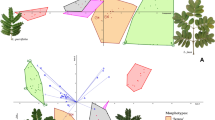Summary
-
1.
Concentric bodies have been detected in the mycobionts of at least forty-three species of lichens, and their presence in two non-lichenized fungi is reported here for the first time. The structure of the bodies appears to be closely similar in all species.
-
2.
A detailed examination of the concentric bodies in electron micrographs of thin sections of Peltigera aphthosa Willd, indicates that the bodies are basically isodiametric in organization. The designation “concentric bodies”, a translation of the term “konzentrische Körper” first used by Peveling (1969a), is therefore preferred to the original name “ellipsoidal bodies” (Brown and Wilson, 1968).
-
3.
Each concentric body is composed of two zones of osmiophilic material surrounding an electron-transparent core. The inner zone is limited internally by a membrane-like boundary. The outer zone has a variable appearance, but often contains radially arranged stainable structures which appear as lamellae in tangential sections. Concentric bodies may collapse under stress into discs with elimination of the core but without apparent rupture of the surrounding material. It is concluded that the bodies are empty or filled with gas or liquid.
-
4.
The bodies occur singly or in clusters and are frequently surrounded by electron-transparent haloes. Clusters of bodies lie within a distinctive matrix which is almost invariably associated with the cell nucleus.
-
5.
Concentric bodies have been found in all types of hyphae in the lichen thallus but not in the asci or ascospores.
-
6.
Interpretations of previous workers are discussed in relation to the present findings, and hypotheses as to the nature of the concentric bodies are put forward.
-
7.
No information is as yet available concerning the origin, development and functions of the concentric bodies, and the question of their possible significance for the lichenized condition remains open.
Similar content being viewed by others
References
Ahmadjian, V., Jacobs, J. B.: The ultrastructure of lichens. III. Endocarpon pusillum. Lichenologist 4, 268–270 (1970).
Ben-Shaul, Y., Paran, N., Galun, M.: The ultrastructure of the association between phycobiont and mycobiont in three ecotypes of the lichen Caloplaca aurantia var. aurantia. J. Microscopie 8, 415–422 (1969).
Brown, R. M., Wilson, R.: Electron microscopy of the lichen Physcia aipolia (Ehrh.) Nyl. J. Phycol. 4, 230–240 (1968).
Chervin, R. E., Baker, G. E., Hohl, H. R.: The ultrastructure of phycobiont and mycobiont in two species of Usnea. Canad. J. Bot. 46, 241–245 (1968).
Duncan, U. K.: Introduction to British Lichens. Arbroath: T. Buncle and Co. Ltd. 1970.
Galun, M., ben-Shaul, Y., Paran, N.: The fungus-alga association in the Lecideaceae: an ultrastructural study. New Phytol. 70, 483–485 (1971a).
Galun, M., Ben-Shaul, Y., Paran, N.: Fungus-alga association in lichens of the Teloschistaceae: an ultrastructural study. New Phytol. 70, 837–839 (1971b).
Galun, M., Paran, N., Ben-Shaul, Y.: Structural modifications of the phycobiont in the lichen thallus. Protoplasma (Wien) 69, 85–96 (1970a).
Galun, M., Paran, N., Ben-Shaul, Y.: The fungus-alga association in the Lecanoraceae: an ultrastructural, study. New Phytol. 69, 599–603 (1970b).
Galun, M., Paran, N., Ben-Shaul, Y.: An ultrastructural study of the fungus alga association in Lecanora radiosa growing under different environmental conditions. J. microscopie 9, 801–806 (1970c).
Galun, M., Paran, N., Ben-Shaul, Y.: Electron microscopic study of the lichen Dermatocarpon hepaticum (Ach.) Th. Fr. Protoplasma (Wien) 73, 457–468 (1971c).
Griffiths, H. B.: The structure of the pyrenomycete ascus. Ph. D. thesis, University of Liverpool 1968.
Jacobs, J. B., Ahmadjian, V.: The ultrastructure of lichens. I. A. general survey. J. Phycol. 5, 227–240 (1969).
Jacobs, J. B., Ahmadjian, V.: The ultrastructure of lichens. II. Cladonia cristatella: the lichen and its isolated symbionts. J. Phycol. 7, 71–82 (1971).
Kellenberger, E., Ryter, A., Séchaud, J.: Electron microscope study of DNA-containing plasms. II. Vegetative and mature phage DNA as compared with normal bacterial nucleoids in different physiological states. J. biophys. biochem. Cytol. 4, 671–678 (1958).
Paran, N., Ben-Shaul, Y., Galun, M.: Fine structure of the blue-green phycobiont and its relation to the mycobiont in two Gonohymenia lichens. Arch. Mikrobiol. 76, 103–113 (1971).
Peat, A.: Fine structure of the vegetative thallus of the lichen, Peltigera polydactyla. Arch. Mikrobiol. 61, 212–222 (1968).
Peveling, E.: Elektronenoptische Untersuchungen an Flechten: IV. Die Feinstruktur einiger Flechten mit Cyanophyceen-Phycobionten. Protoplasma (Wien) 68, 209–222 (1969a).
Peveling, E.: Elektronenoptische Untersuchungen an Flechten: III. Cytologische Differenzierungen der Pilzzellen im Zusammenhang mit ihrer symbiontischen Lebensweise. Z. Pflanzenphysiol. 61, 151–164 (1969b).
Reznik, H., Peveling, E., Vahl, J.: Die Verschiedenartigkeit von Haftorganen einiger Flechten. Untersuchungen mit dem Oberflächen-Rasterelektronenmikroskop und dem Durchlichtelelektronenmikroskop. Planta (Berl.) 78, 287–292 (1968).
Roskin, P. A.: Ultrastructure of the host-parasite interaction in the basidiolichen Cora pavonia (Web.) E. Fries. Arch. Mikrobiol. 70, 176–182 (1970).
Schreil, W. H.: Studies on the fixation of artificial and bacterial DNA plasms for the electron microscopy of thin sections. J. Cell Biol. 22, 1–20 (1964).
Tibell, L., v. Hofsten, A.: Spore evolution of the lichen Texosporium sancti-jacobi (=Cyphelium sancti-jacobi). Mycologia (N.Y.) 60, 553–558 (1968).
Walker, A. T.: Fungus-alga ultrastructure in the lichen, Cornicularia normoerica. Amer. J. Bot. 55, 641–648 (1968).
Walsby, A. E., Buckland, B.: Isolation and purification of intact gas vesicles from a blue-green alga. Nature (Lond.) 224, 716–717 (1969).
Webber, M. M., Webber, P. J.: Ultrastructure of lichen haustoria: symbiosis in Parmelia sulcata. Canad. J. Bot. 48, 1521–1524 (1970).
Author information
Authors and Affiliations
Rights and permissions
About this article
Cite this article
Griffiths, H.B., Greenwood, A.D. The concentric bodies of lichenized fungi. Archiv. Mikrobiol. 87, 285–302 (1972). https://doi.org/10.1007/BF00409130
Received:
Issue Date:
DOI: https://doi.org/10.1007/BF00409130




